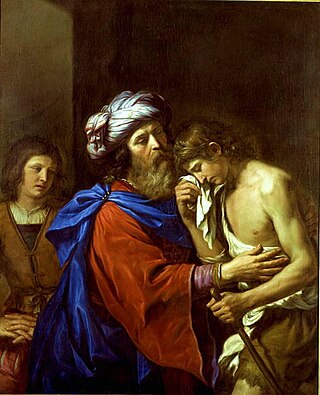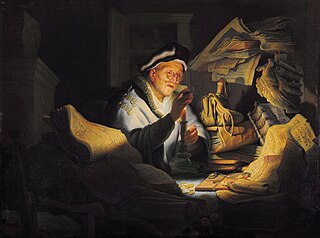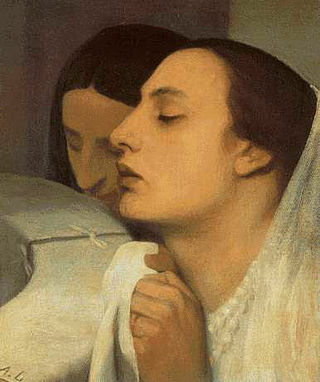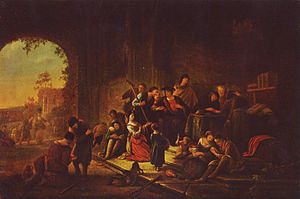
Mark 12 is the twelfth chapter of the Gospel of Mark in the New Testament of the Christian Bible. It continues Jesus' teaching in the Temple in Jerusalem, and contains the parable of the Wicked Husbandmen, Jesus' argument with the Pharisees and Herodians over paying taxes to Caesar, and the debate with the Sadducees about the nature of people who will be resurrected at the end of time. It also contains Jesus' greatest commandment, his discussion of the messiah's relationship to King David, condemnation of the teachers of the law, and his praise of a poor widow's offering.

The Parable of the Talents is one of the parables of Jesus. It appears in two of the synoptic, canonical gospels of the New Testament:

The parables of Jesus are found in the Synoptic Gospels and some of the non-canonical gospels. They form approximately one third of his recorded teachings. Christians place great emphasis on these parables, which they generally regard as the words of Jesus.

The Good Shepherd is an image used in the pericope of John 10:1–21, in which Jesus Christ is depicted as the Good Shepherd who lays down his life for his sheep. Similar imagery is used in Psalm 23 and Ezekiel 34:11–16. The Good Shepherd is also discussed in the other gospels, the Epistle to the Hebrews, the First Epistle of Peter and the Book of Revelation.

The Parable of the Unforgiving Servant is a parable of Jesus which appears in the Gospel of Matthew. According to Matthew 18:21–35 it is important to forgive others as we are forgiven by God, as illustrated by the negative example of the unforgiving servant.

The Parable of the Wicked Husbandmen, also known as the Parable of the Bad Tenants, is a parable of Jesus found in the Gospel of Matthew, the Gospel of Mark and the Gospel of Luke. It is also found in the non-canonical Gospel of Thomas. It describes a landowner planting a vineyard and letting it out to husbandmen who failed in their duties.

The Parable of the Two Sons is a parable told by Jesus in the New Testament, found in Matthew. It contrasts the tax collectors and prostitutes who accepted the message taught by John the Baptist with the ostensibly religious people who did not.

The Parable of the Rich Fool is a parable of Jesus which appears in the Gospel of Luke. It depicts the futility of the belief that wealth can secure prosperity or a good life.

The Parable of the Friend at Night is a parable of Jesus which appears in Luke 11:5–8. In it, a friend eventually agrees to help his neighbor due to his persistent demands rather than because they are friends, despite the late hour and the inconvenience of it.

Luke 10 is the tenth chapter of the Gospel of Luke in the New Testament of the Christian Bible. It records the sending of seventy disciples by Jesus, the famous parable about the Good Samaritan, and his visit to the house of Mary and Martha. This Gospel's author, who also wrote the Acts of the Apostles, is not named but is uniformly identified by early Christian tradition as Luke the Evangelist.

The Parable of the Great Banquet or the Wedding Feast or the Marriage of the King's Son is a parable told by Jesus in the New Testament, found in Matthew 22:1–14 and Luke 14:15–24.

The True Vine is an allegory or parable given by Jesus in the New Testament. Found in John 15:1–17, it describes Jesus' disciples as branches of himself, who is described as the "true vine", and God the Father the "husbandman".

The Parable of the Master and Servant is a parable told by Jesus in the New Testament, found only in Luke's Gospel. The parable teaches that when somebody "has done what God expects, he or she is only doing his or her duty."

Matthew 20 is the twentieth chapter in the Gospel of Matthew in the New Testament of the Christian Bible. Jesus continues his final journey through Perea and Jericho, heading towards Jerusalem, which he enters in the following chapter.

Matthew 22 is the twenty-second chapter in the Gospel of Matthew in the New Testament section of the Christian Bible. Jesus continues his final ministry in Jerusalem before his Passion. Teaching in the Temple, Jesus enters into debate successively with the Pharisees, allied with the Herodians, the Sadducees, and a lawyer, ultimately silencing them all.

Luke 13 is the thirteenth chapter of the Gospel of Luke in the New Testament of the Christian Bible. It records several parables and teachings told by Jesus Christ and his lamentation over the city of Jerusalem. Jesus resumes the journey to Jerusalem which he had embarked upon in Luke 9:51. This chapter, taken with Luke 12:54-59, begins to outline and illustrate "the problem with the Jewish nation" which accounts for the urgency of his journey to Jerusalem. The book containing this chapter is anonymous, however early Christian tradition generally accepts that Luke the Evangelist composed this Gospel as well as the Acts of the Apostles.

Luke 16 is the sixteenth chapter of the Gospel of Luke in the New Testament of the Christian Bible. It records the teachings and parables of Jesus Christ, including the account of the "rich man and Lazarus". There is an "overriding concern with riches" in this chapter, although other topics are also covered. The book containing this chapter is anonymous, but early Christian tradition uniformly affirmed that Luke the Evangelist composed this Gospel as well as the Acts of the Apostles.
Luke 20 is the twentieth chapter of the Gospel of Luke in the New Testament of the Christian Bible. It records the teaching of Jesus Christ in the temple in Jerusalem, especially his responses to questions raised by the Pharisees and Sadducees. The book containing this chapter is anonymous, but early Christian tradition uniformly affirmed that Luke the Evangelist composed this Gospel as well as the Acts of the Apostles.

The parable of the barren fig tree is a parable of Jesus which appears in Luke 13:6–9. It is about a fig tree which does not produce fruit.
The Parable of the Empty Jar, is found in the non-canonical Gospel of Thomas. It does not appear in any of the Canonical gospels of the New Testament.


















